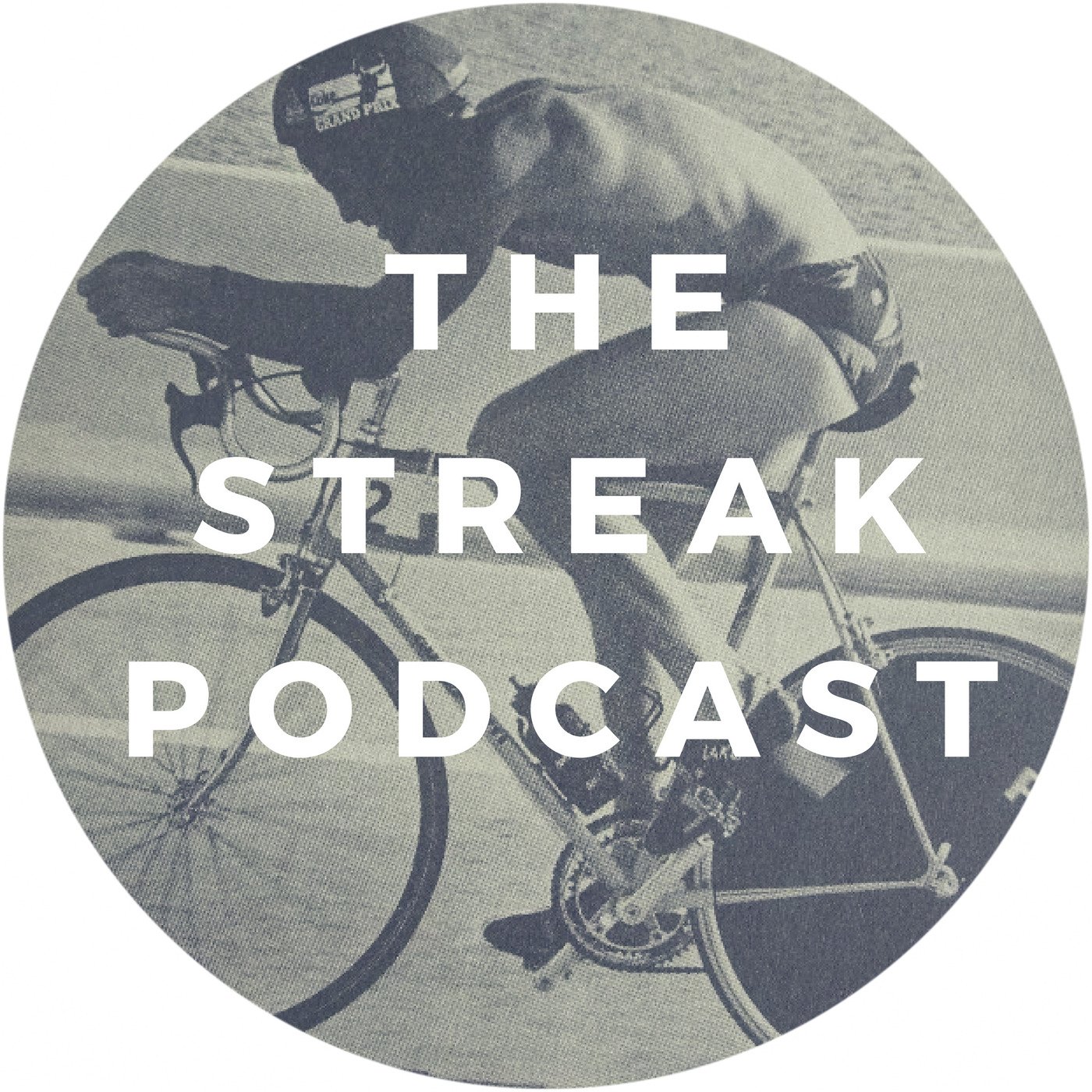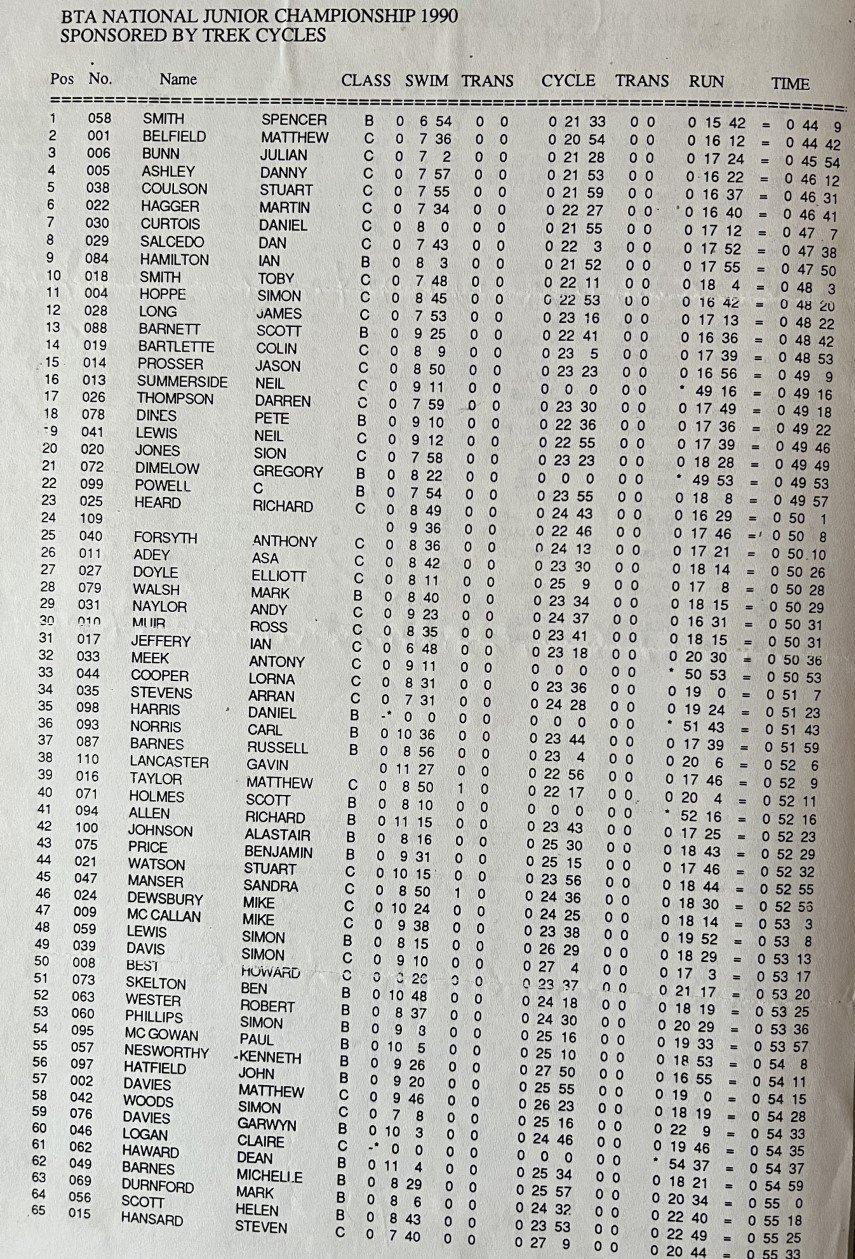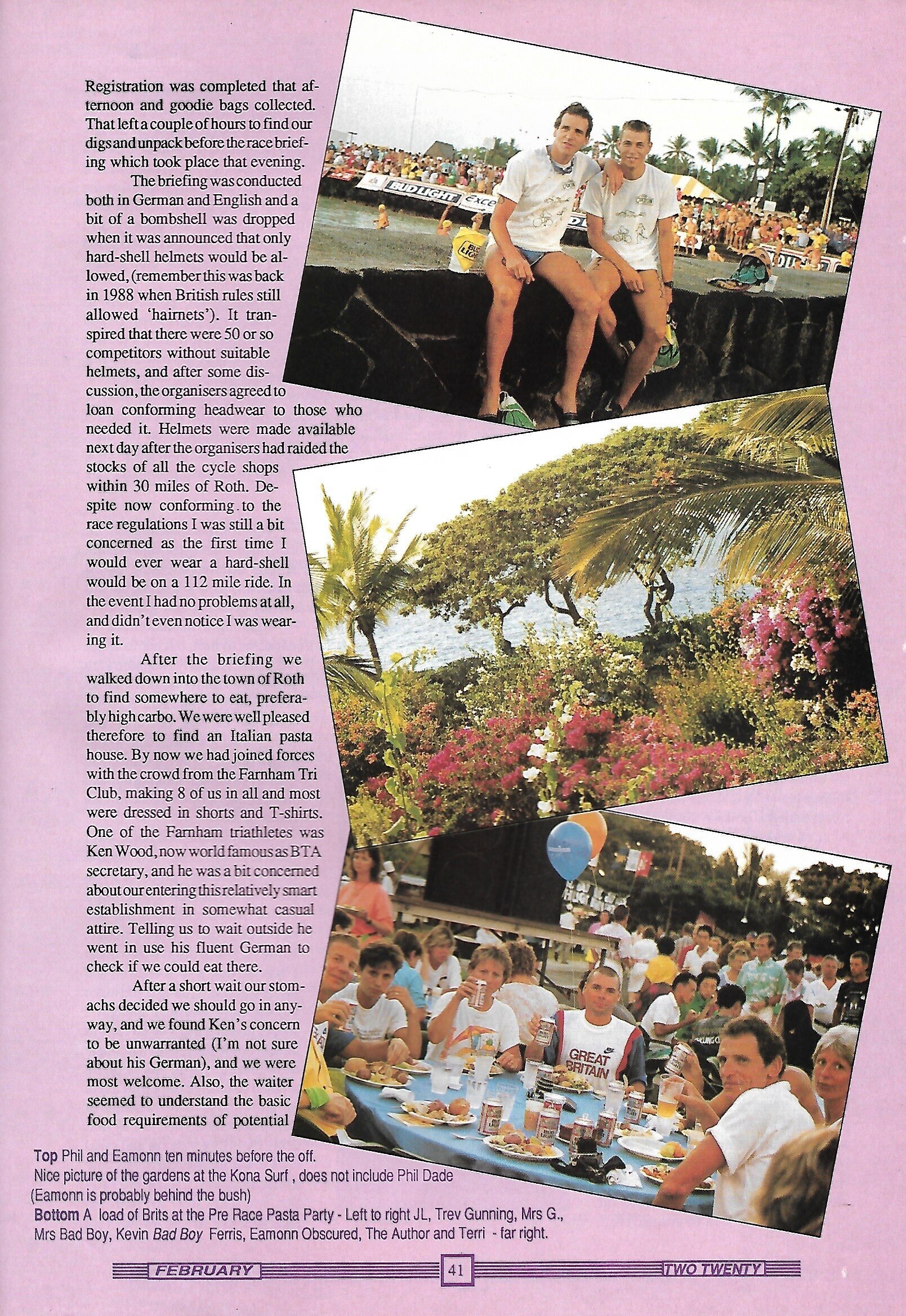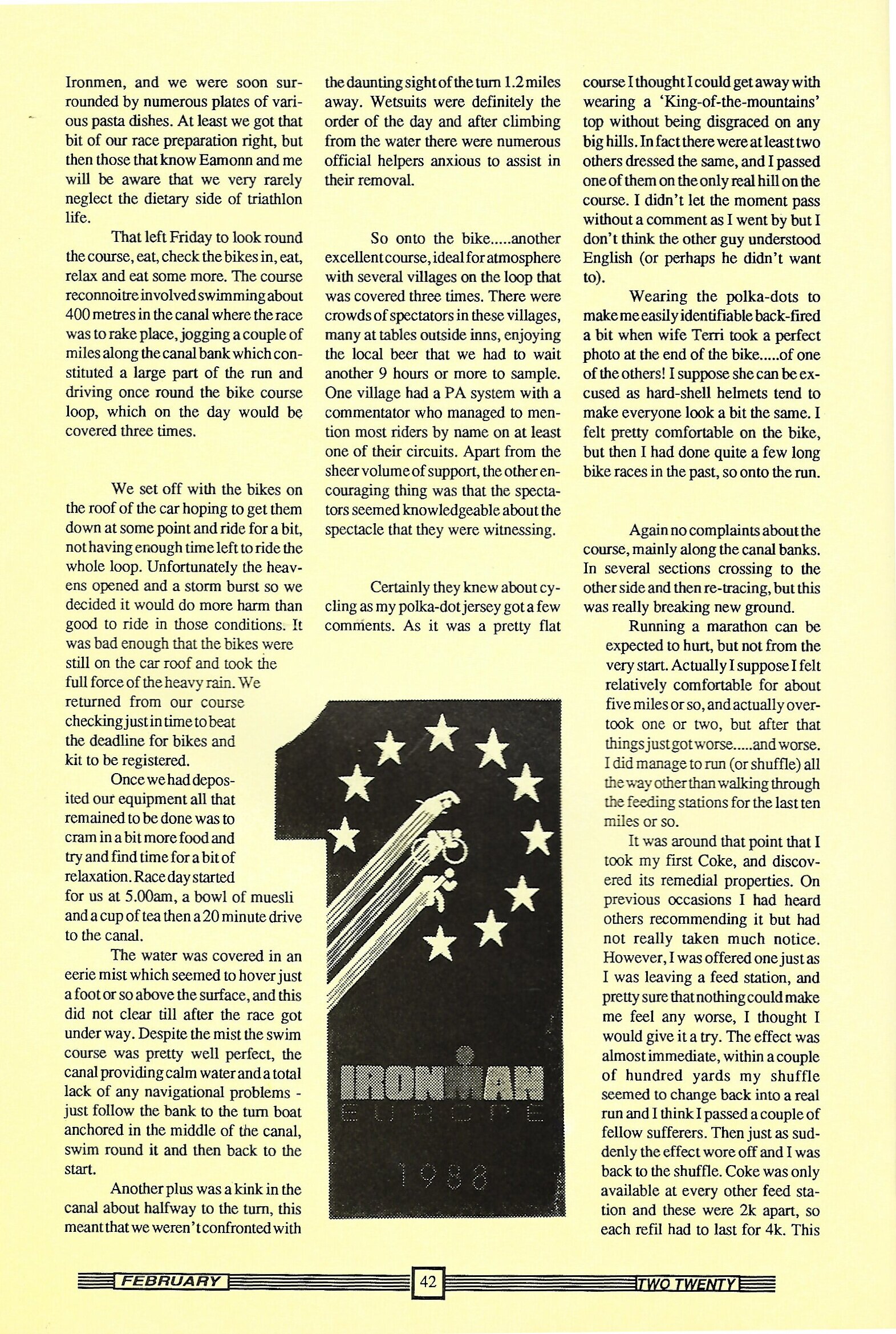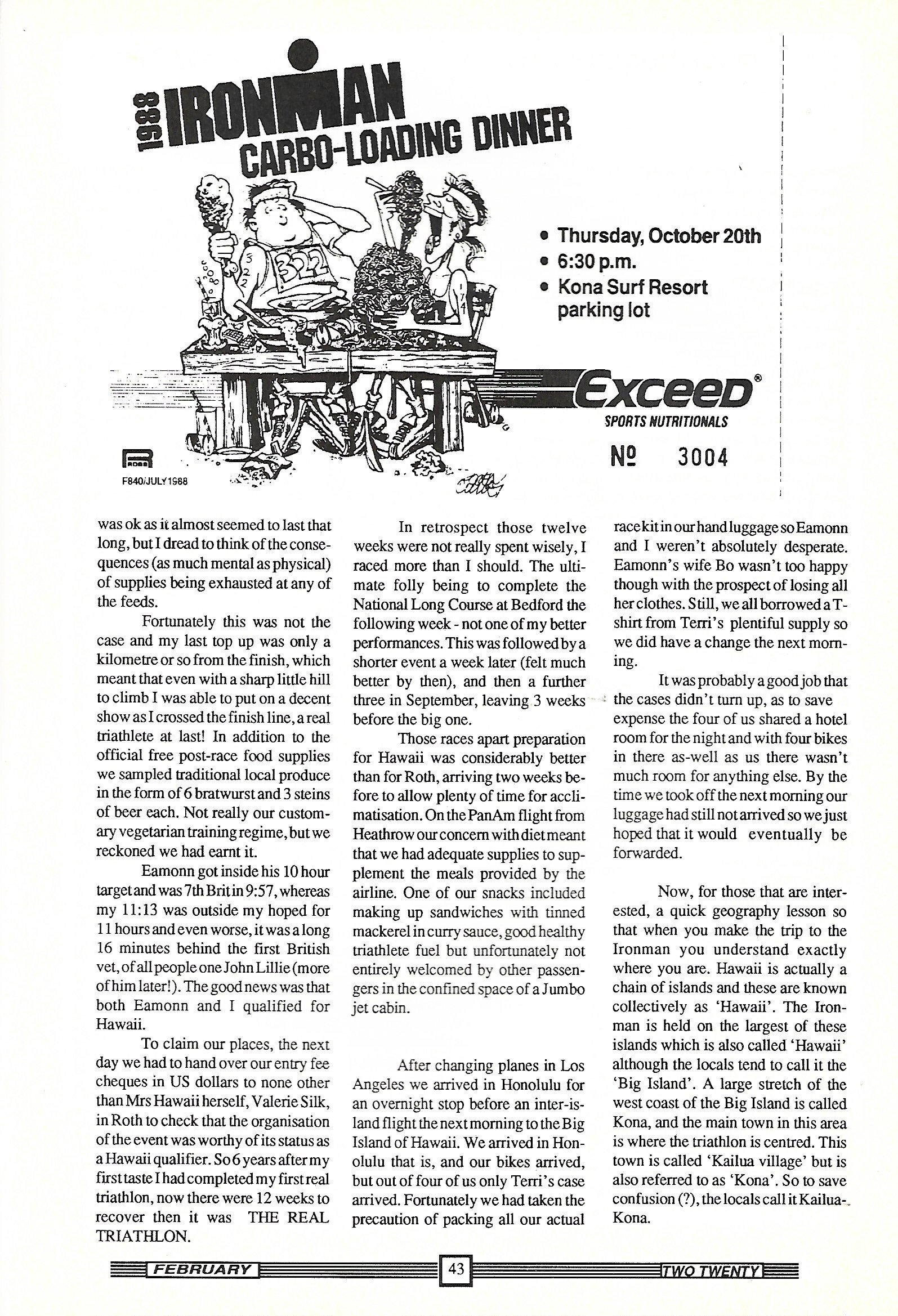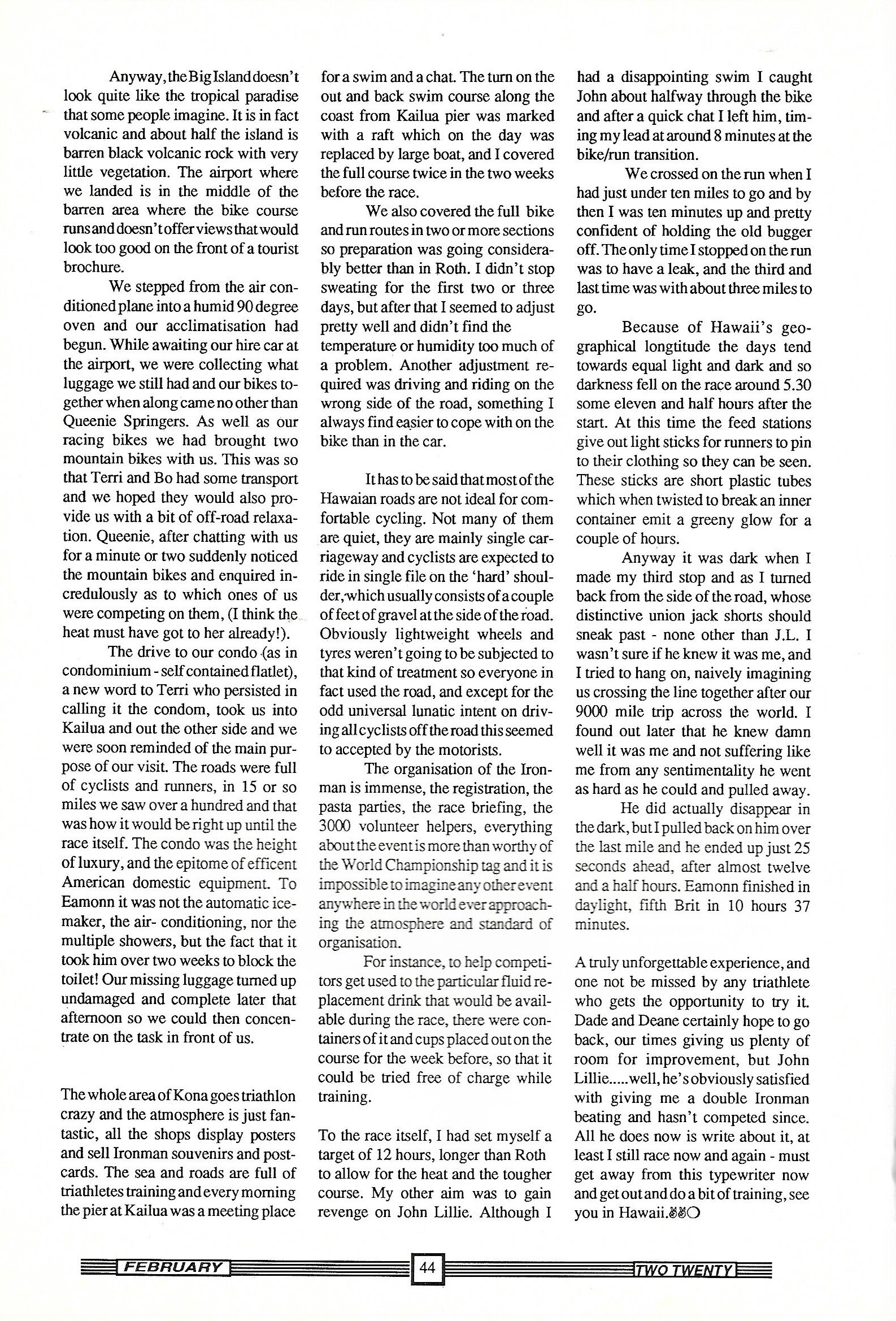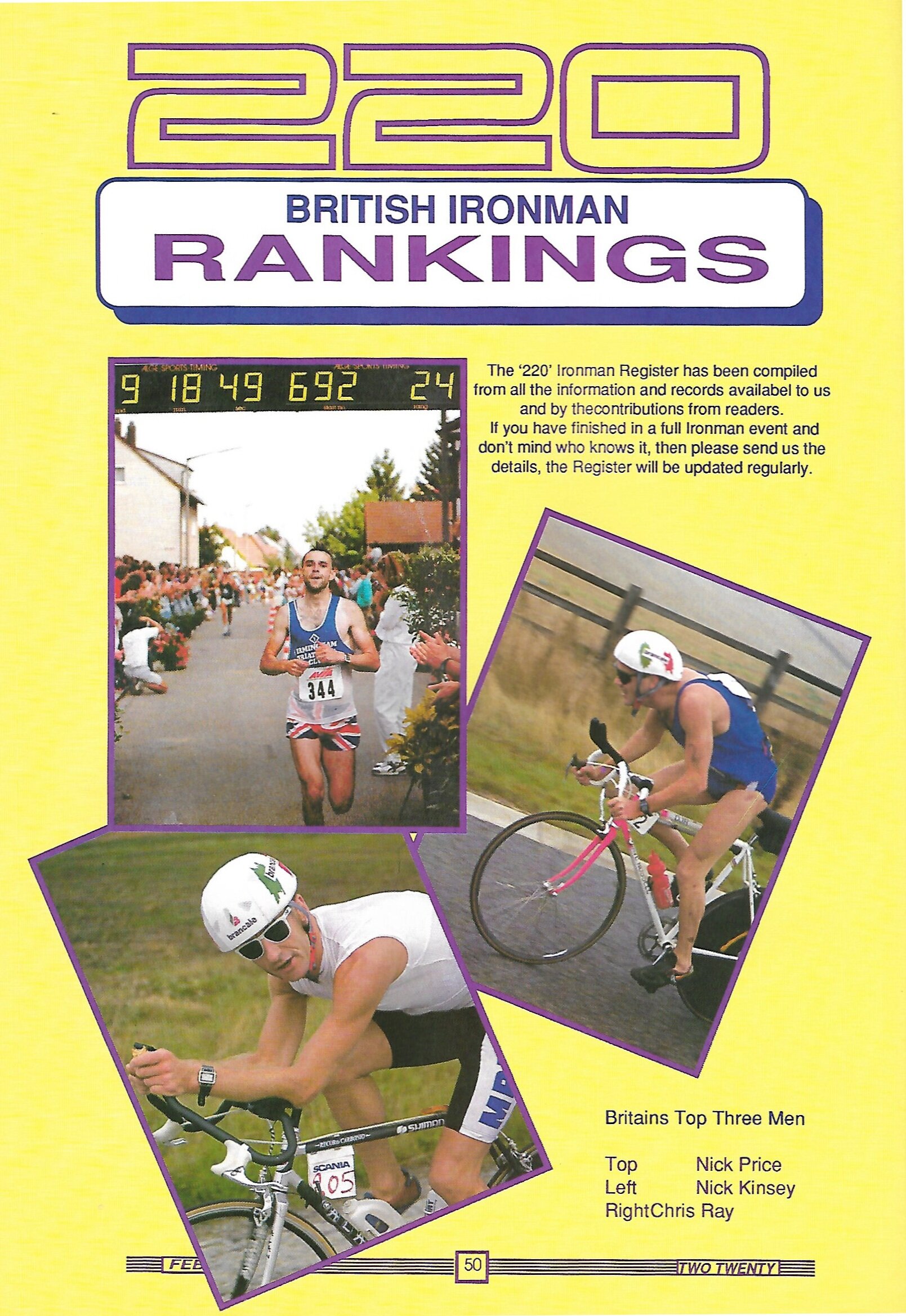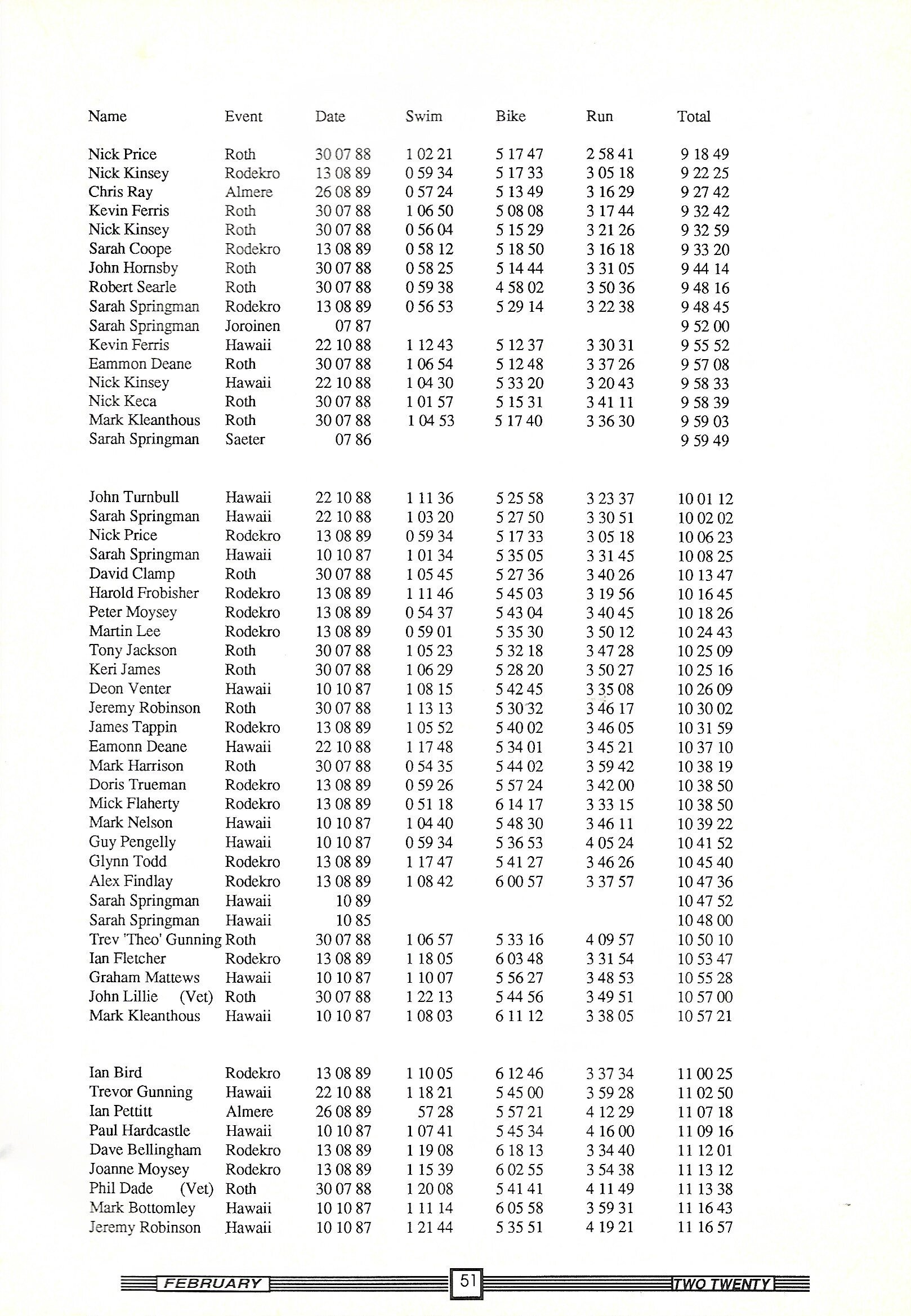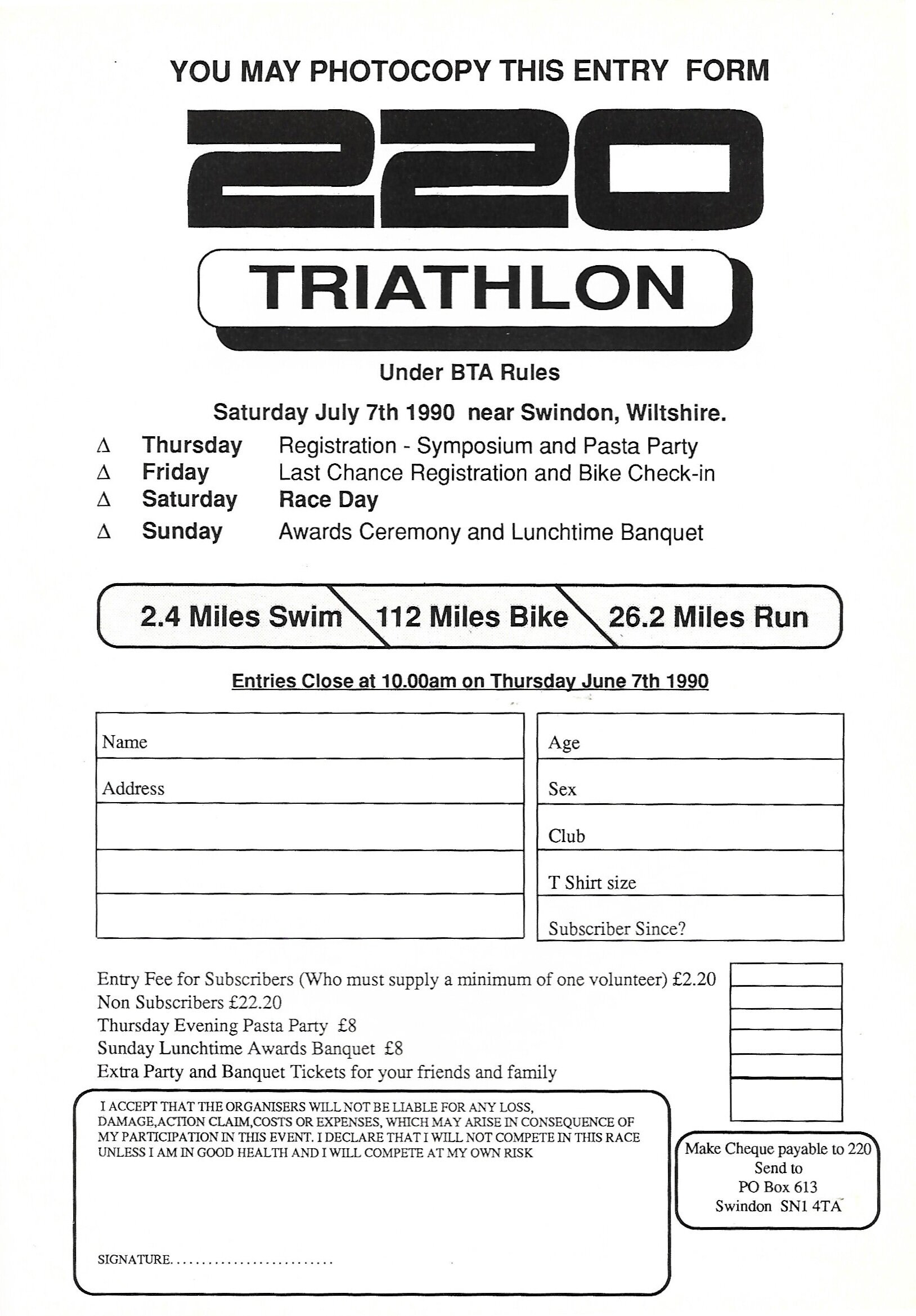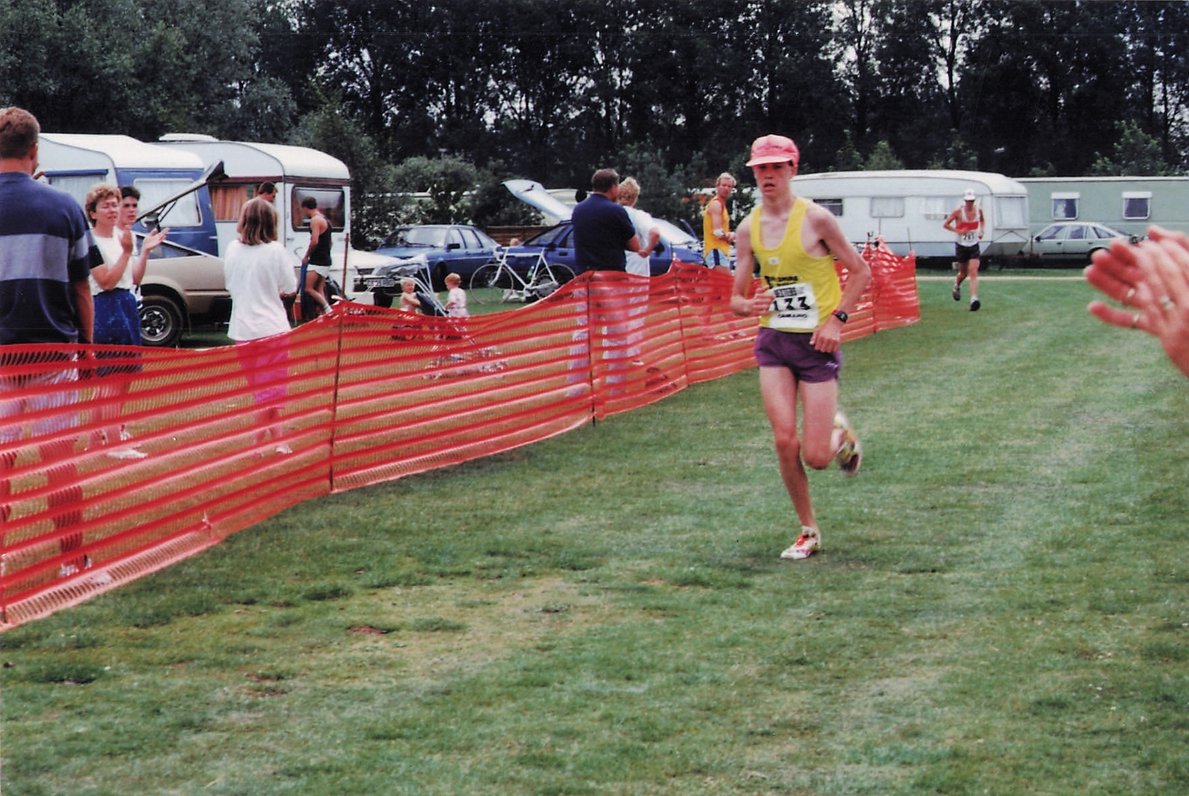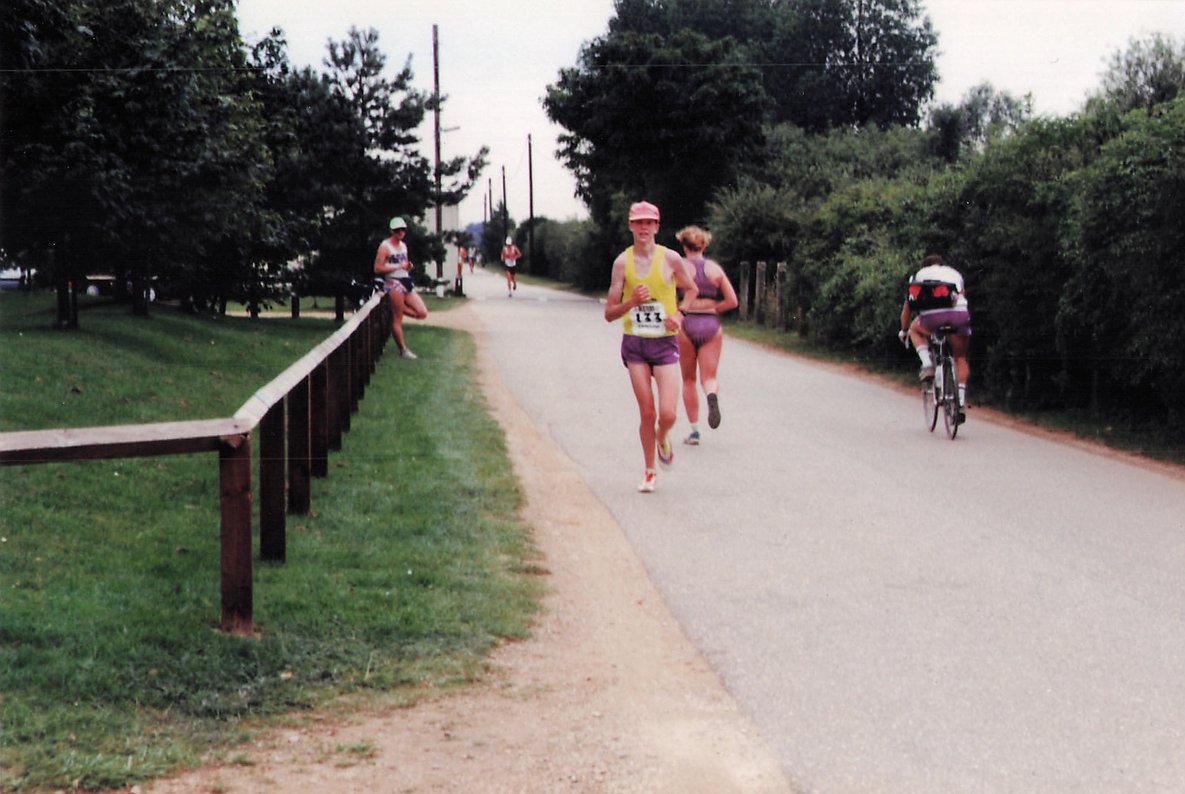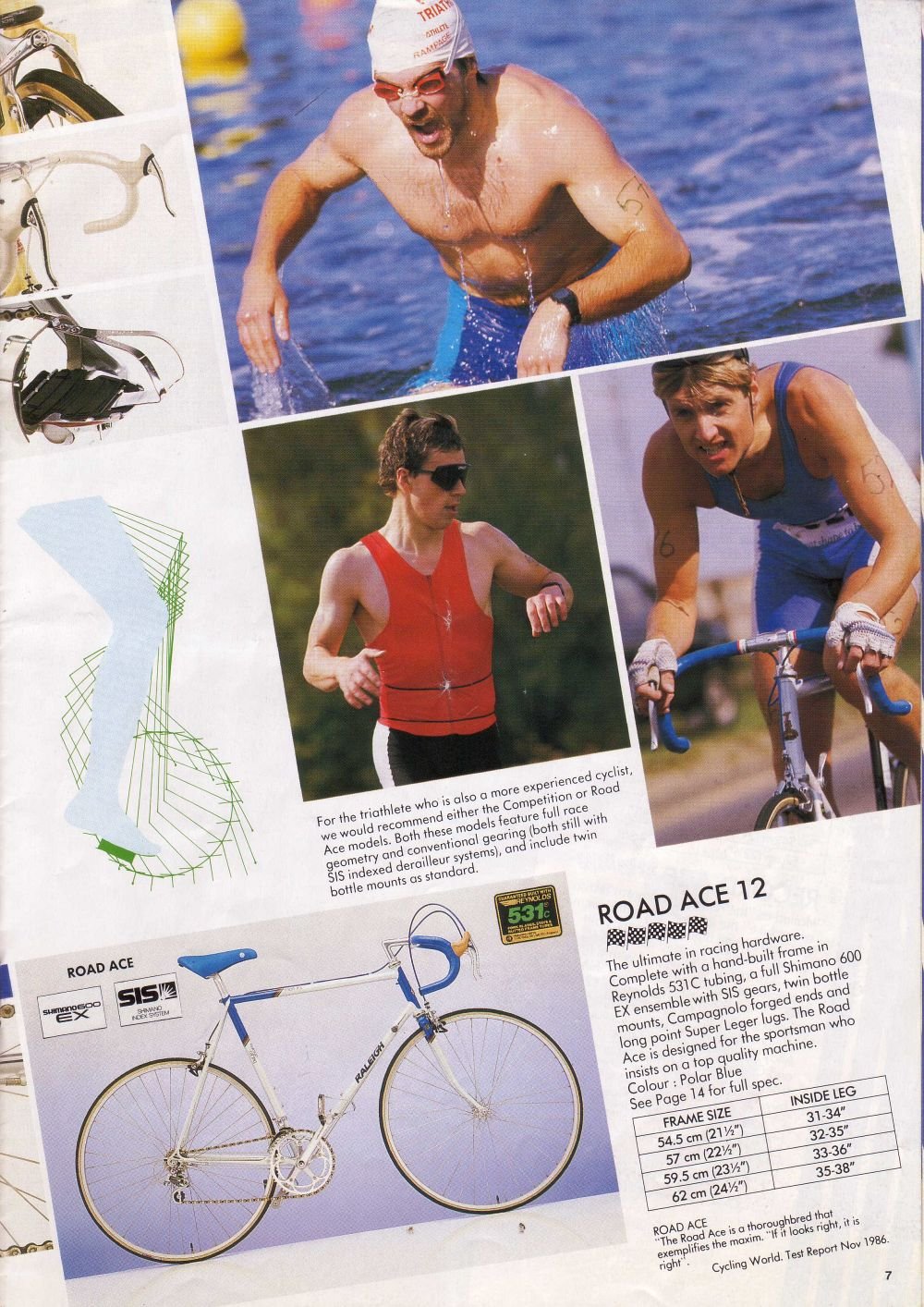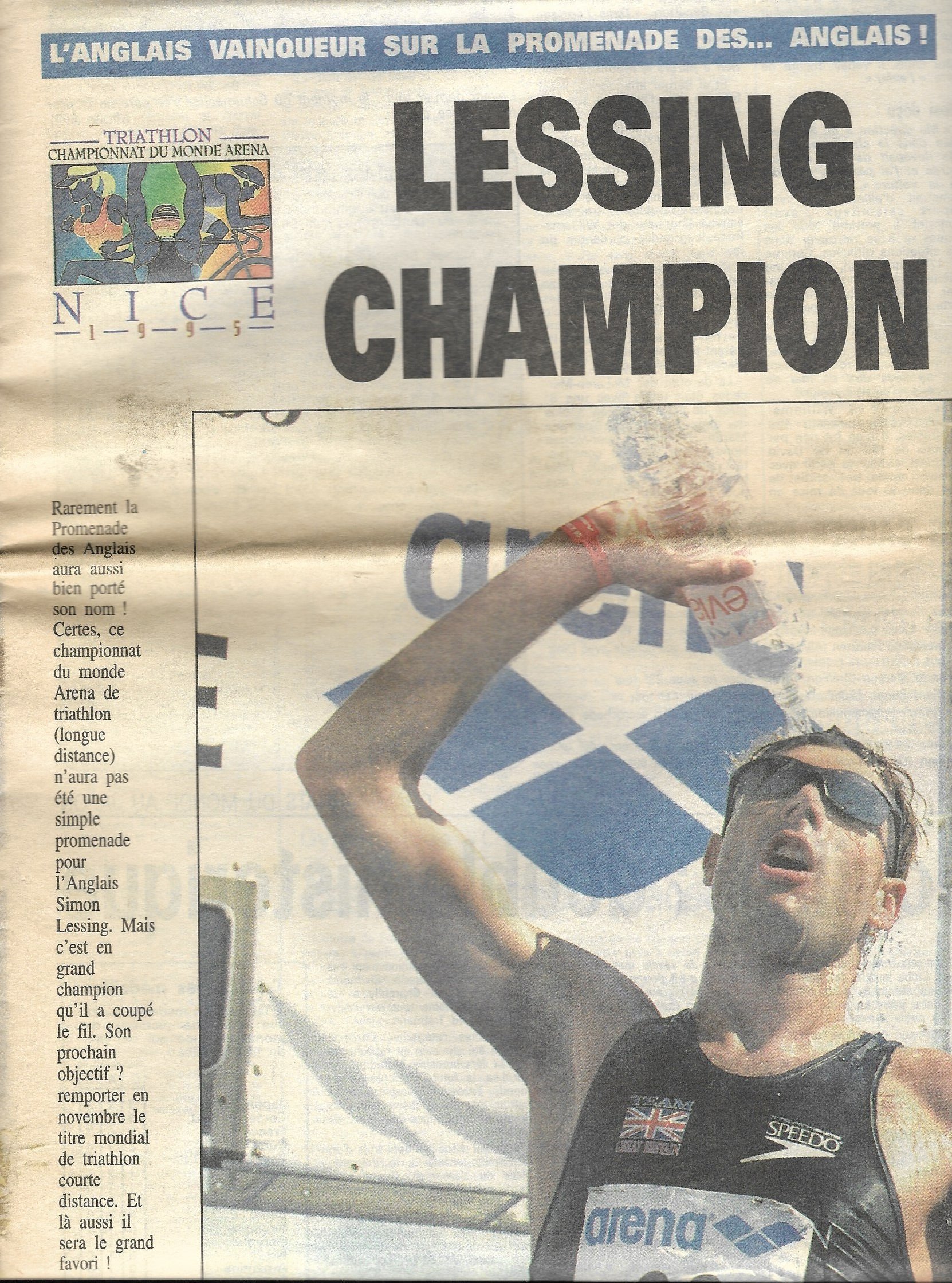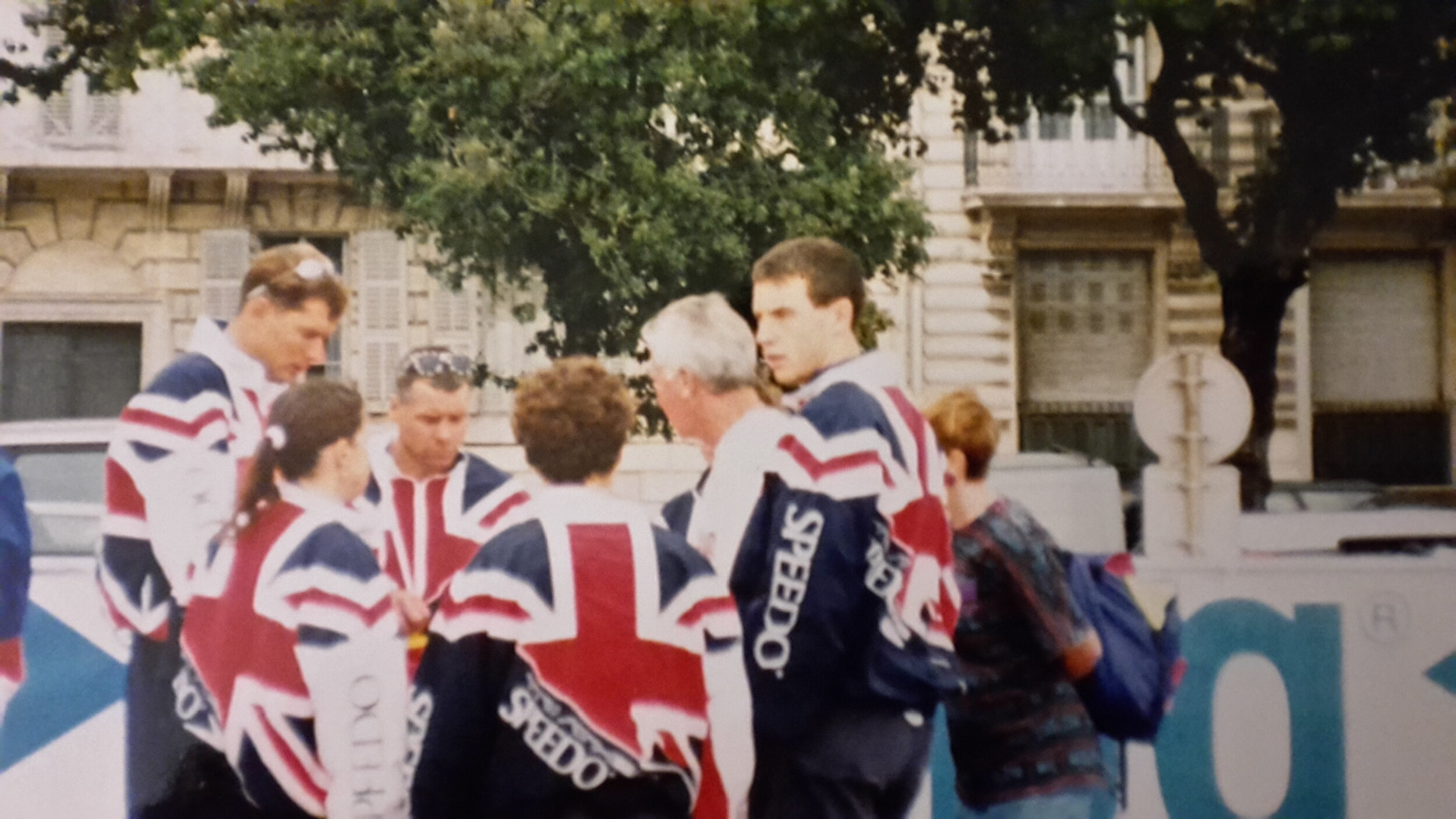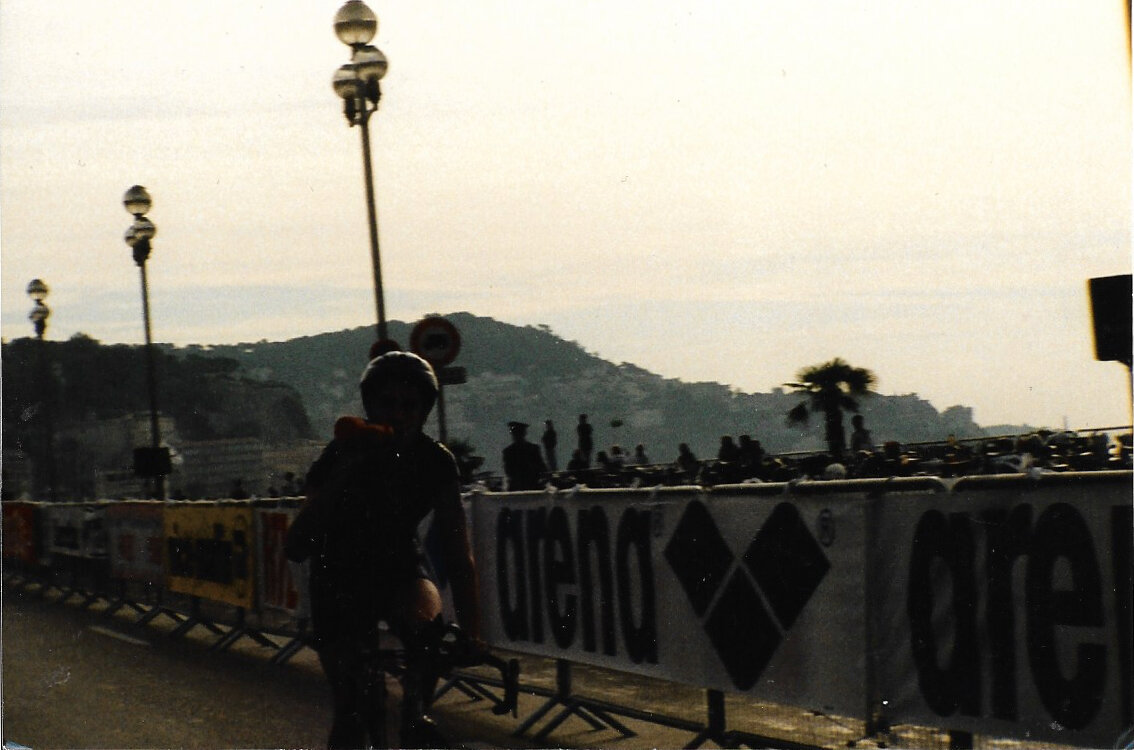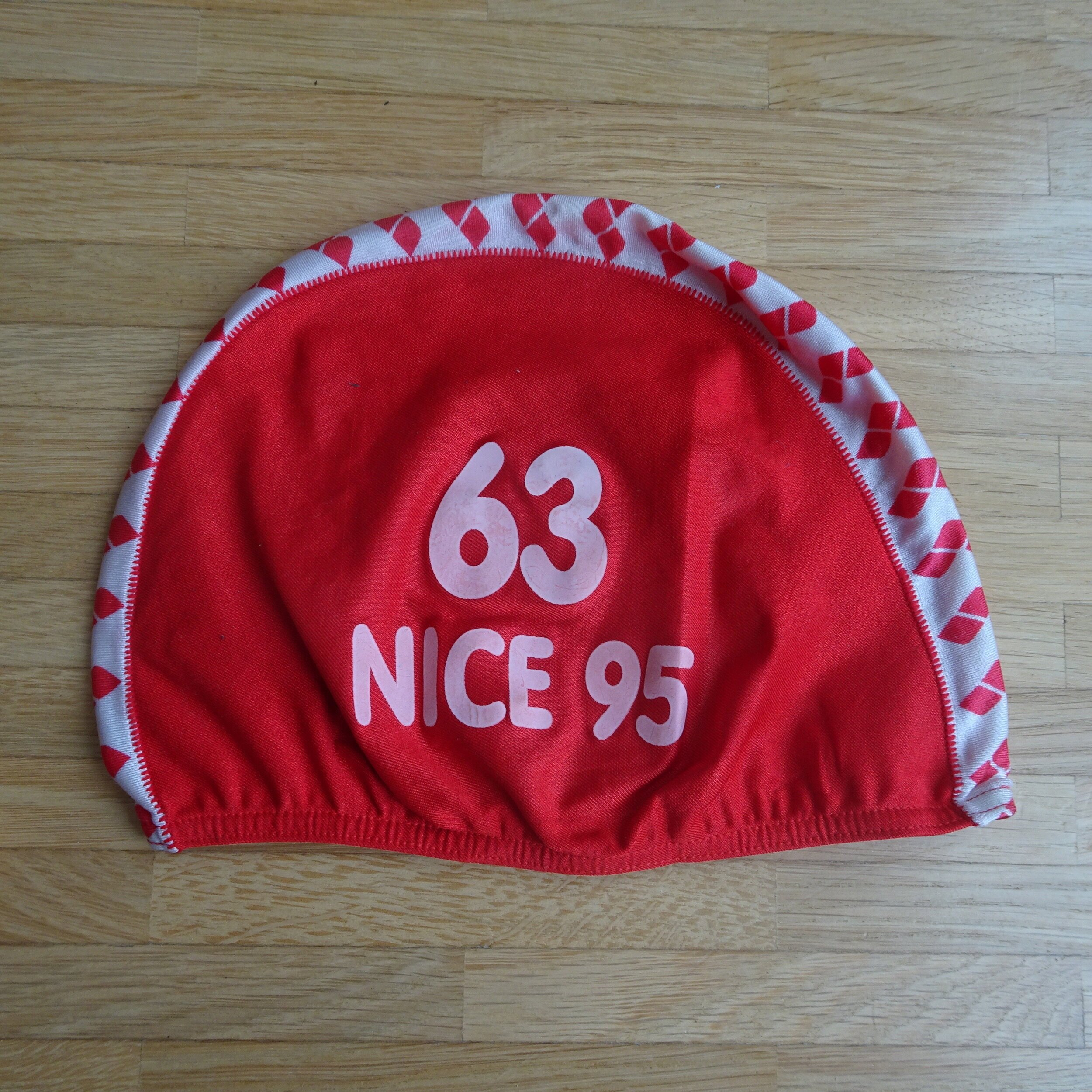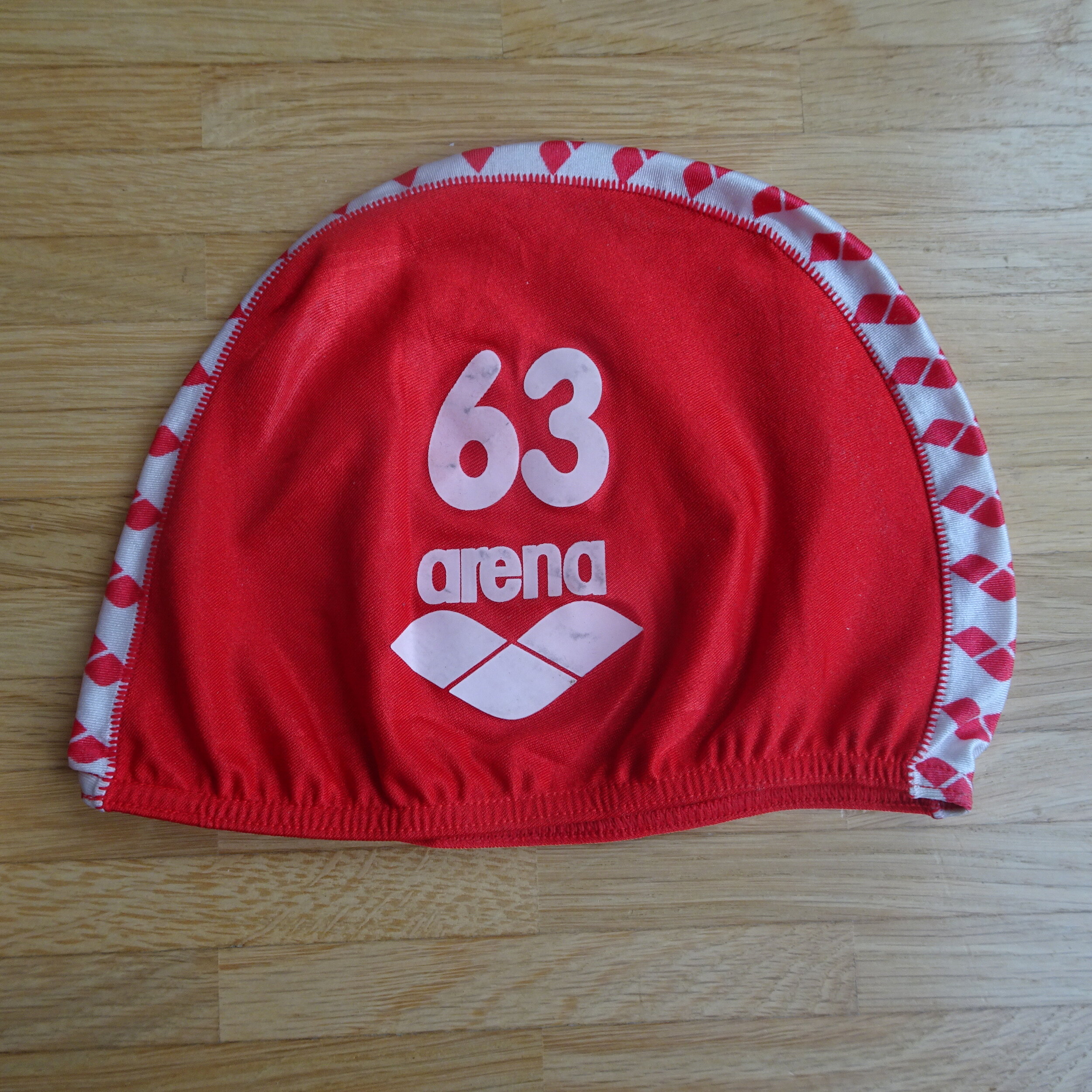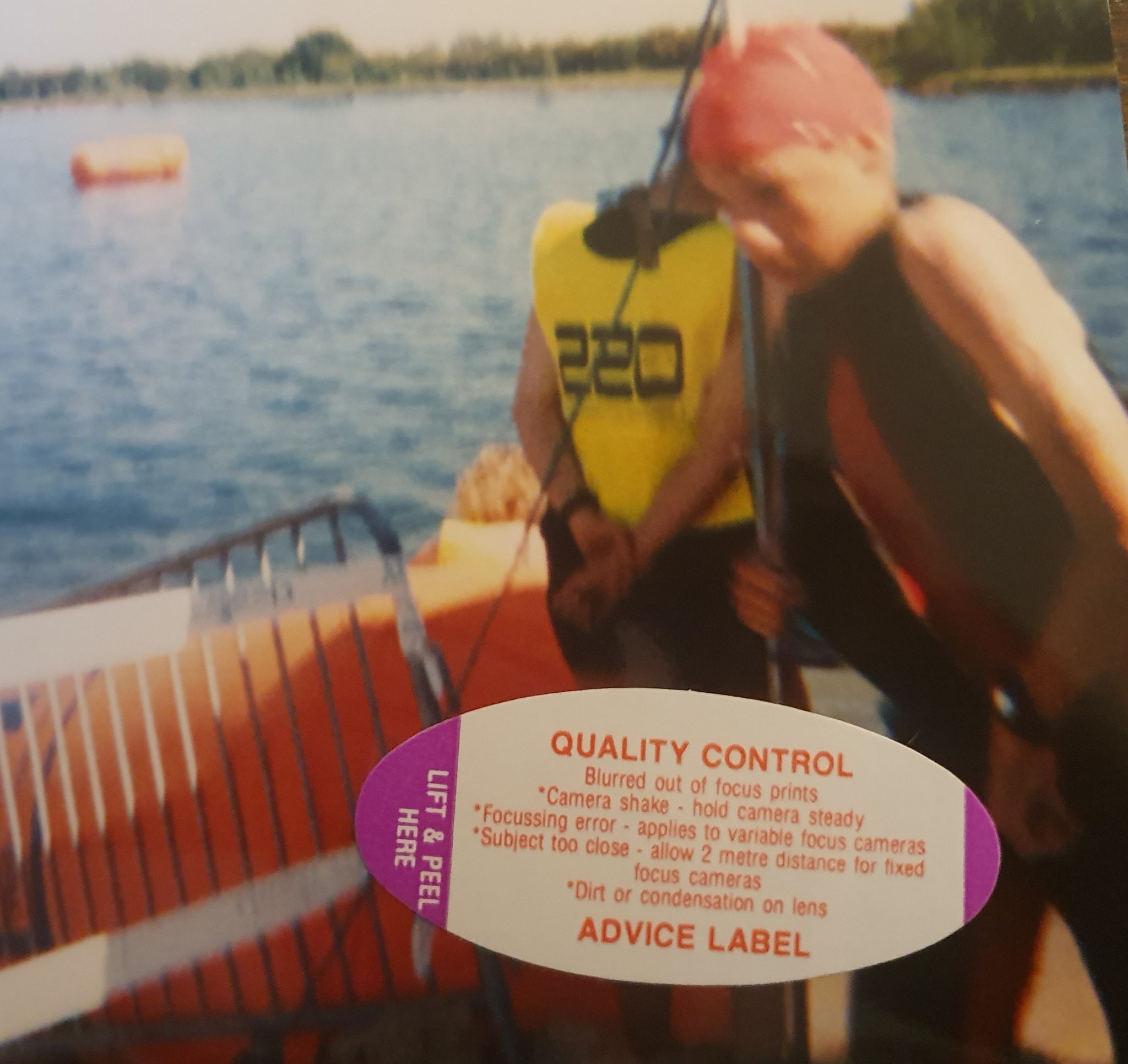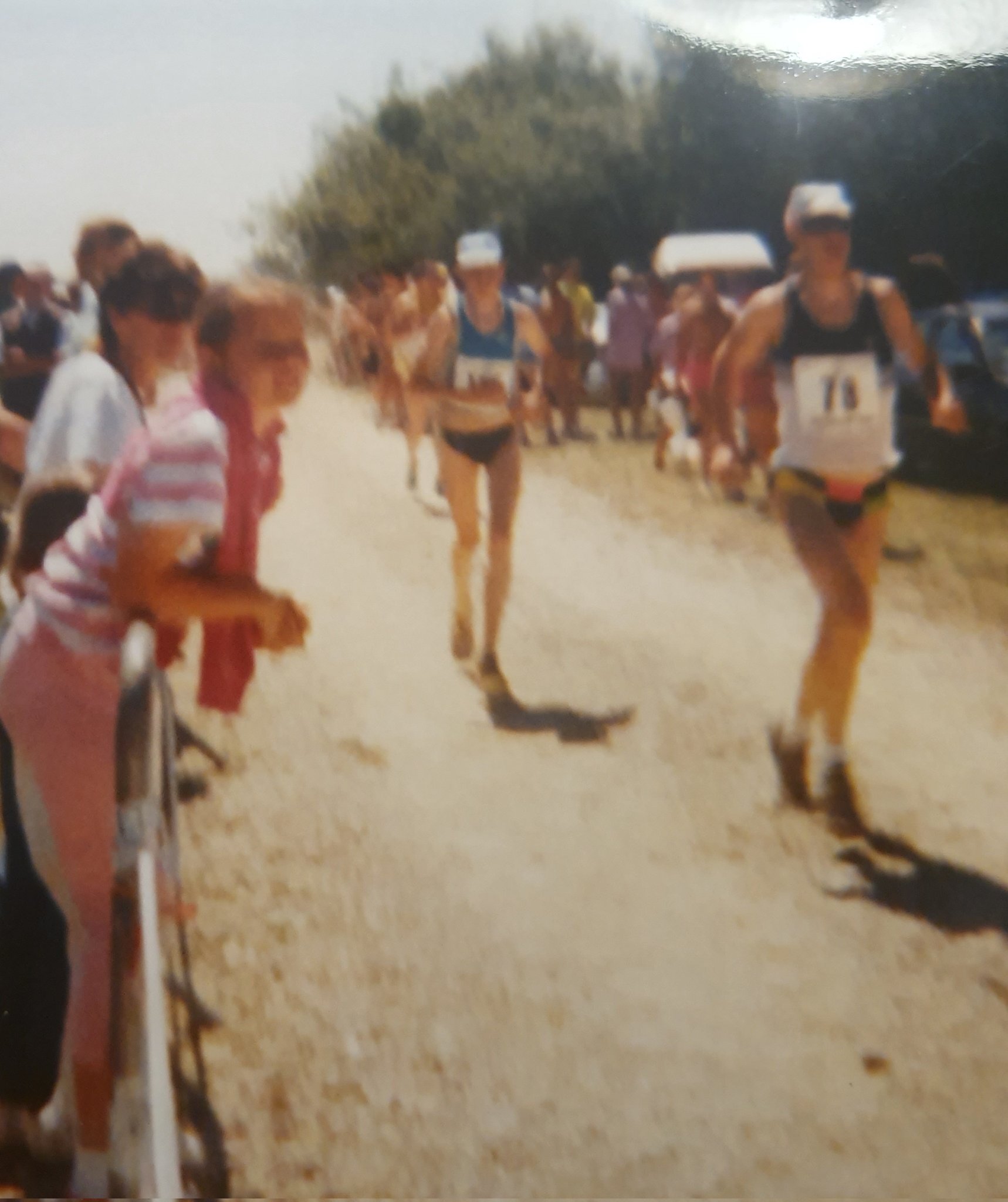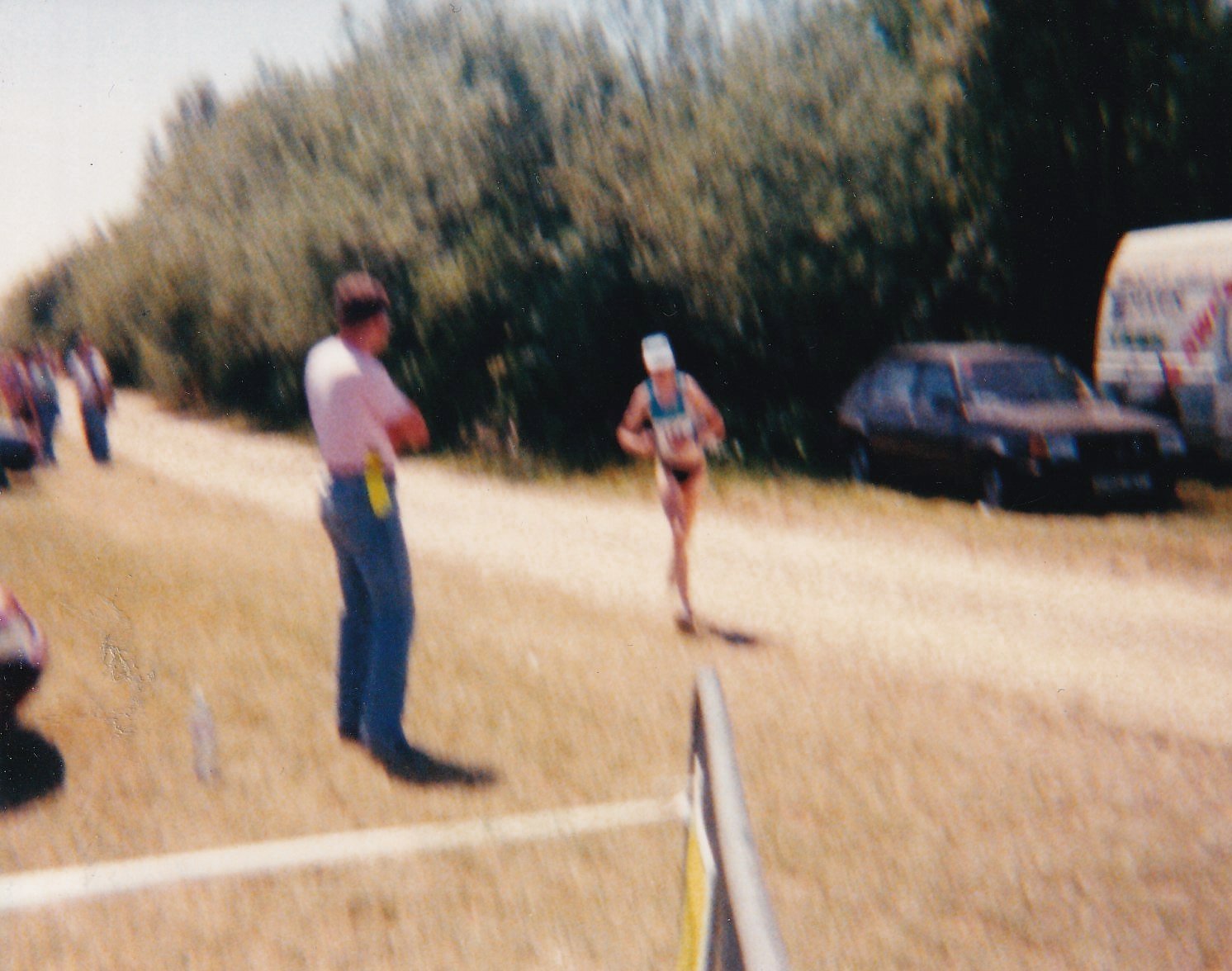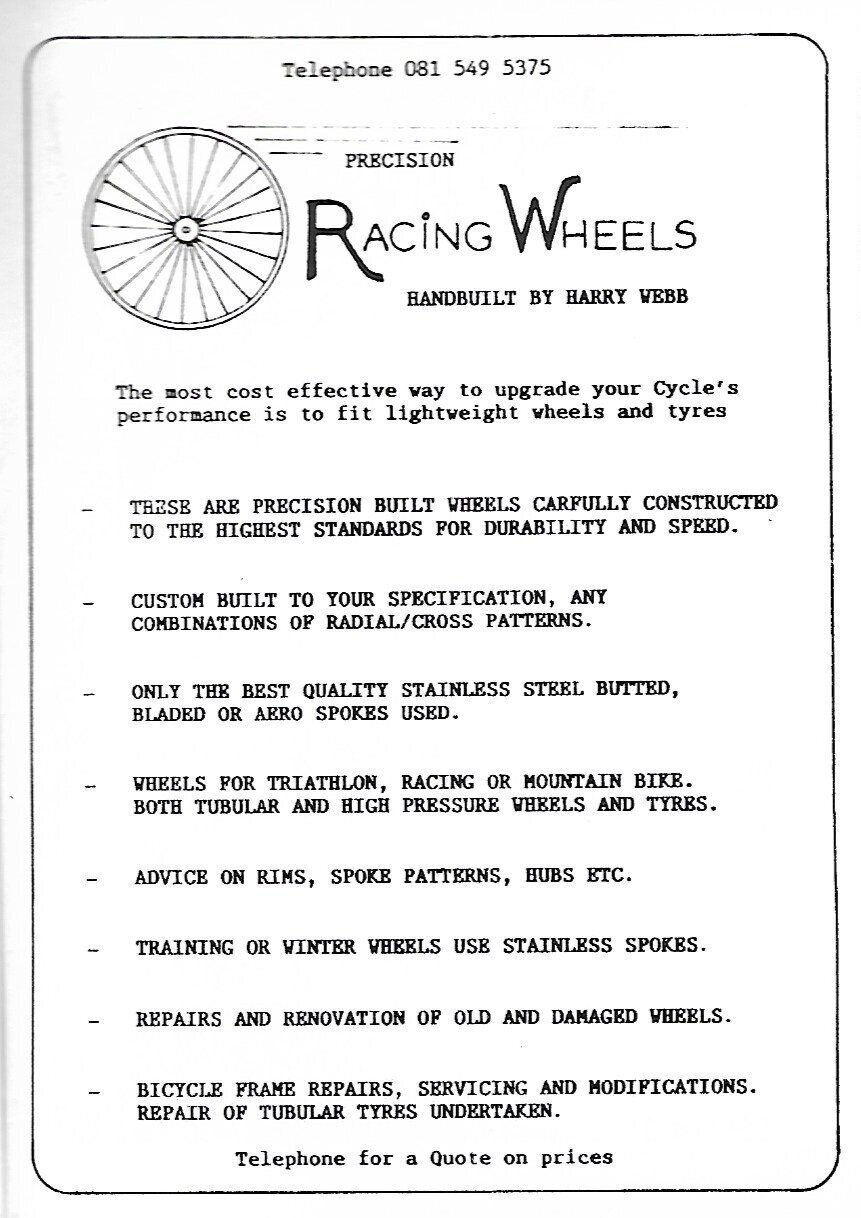My First Helmet
This is the Vetta Corsa. Here it’s being worn by Mark Marabini at the 1988 Warburton’s Big Bread Triathlon in Southport. Nice MB bars too!
I bought mine in 1988 from Stowes Cycles at the end of Slough High Street. They were known for their friendly service. Said nobody ever.
It might not have been lightweight. Or aero. But it was safe. As it was made from military grade, bullet-proof kevlar.
I wore it proudly through the 1989 and 1990 triathlons seasons.
Image: Triathlete (USA) May 1987
The Rest Of 1990
My plan for the 1990 triathlon season was to take my Skoda Estelle on tour and do the Carlsberg Grand Prix. The BTA released plans to restructure the series. But unfortunately it never went ahead.
However, I still did my first Olympic Distance race in Swindon and focused the rest of the season on local events such as the BTS Gravel Pit races and the monthly Harry Kitchener Series in Biggleswade.
Preparation for the season started in November 1989 by attending a training camp in Reading (below). I met other people hooked on the sport and rode the velodrome at Palmer Park. This would become a regular training venue until I left the country forever in 1996.
To further prove my growing tri-nerd creditials I also got a letter published in the February issue of 220 magazine.
At Christmas I got my first turbo trainer from Geoffrey Butler cycles in Croydon. It was a Tacx, front wheel off, fan-flywheel model.
On cold nights I’d crank the Genesis in my parents’ garage and follow sessions from Advanced Turbo Training by Peter Read. I destroyed the fan piece numerous times before retiring the trainer in the late 90s.
As I was planning to study Sports Science at university I wrote to Robin Brew to see if I could help out at one of his training camps. He said yes. Top bloke. And I attended the May novice course below.
Image: 220 (UK) January 1990
Ever since I got a road bike, maybe in 1987, and started doing longer rides out of Slough, I had been doing my own wrenching. Learning by trial and error and getting the occasional tip from Dave Russell.
So it’s surprising to me that it took until the middle of 1990 to have a self-inflicted, race-ending mechanical. It happened at the Farmer Giles Super Sprint Triathlon in Aylesbury. Race report below.
Images: 220 (UK) August 1990
In the week before the race I carried out my first cassette removal and clean. But I clearly didn’t re-tighten the lock-nut enough. So mid-race all the sprockets moved right, off the free-hub. Lesson learnt.
As a fan I was psyched to follow the 220 Marathon Triathlon. This was the ironman distance event organised out of Cotswold Water Park by the 220 Magazine crew. Entry fee was only £2:20 for subscribers.
Images: 220 (UK) May 1990. 220 (UK) July 1990.
A race report is below. I’d actually considered entering. But I found out that I was too young. It would have been a complete disaster. In 1991 they moved the event to Ironbridge and even had Kona slots.
Images: 220 (UK) August 1990. Triathlete (UK) August 1990.
I was hoping to end my season at the Portsmouth International Triathlon. It was the race organised by Tri-Athlete Magazine. In 1988 and 1989 the event was held in Southport. And in 1989 it was covered by the BBC.
But my entry was returned because I wasn’t 18. I remember writing back to say that Spencer Smith also wasn’t 18 yet but they’d accepted his entry anyway. I guess they thought he was going to be a big deal.
Again. Full blog post on that event coming soon.
Image: 220 (UK) August 1990
I ended my junior career by gettting a drafting penalty at the national championships at Holme Pierrepont. My brother, pictured in the race report below, got the crowd pumped by ripping a 10m skid into T2.
The next day I took part in the national relay championships with Berkshire Tri Squad for the second time. The event is still truckin’ with essentially the same format. I’d love to go back one day.
Images: 220 (UK) September 1990
1987 L. Ron Hubbard Triathlon
Image: Tri-Athlete (UK) May 1987
I’m not a member of any religion. But this race intrigues me. Maybe the sponsorship was a recruitment or PR move. I could have done it. As it took place only 10 miles from my home. Two days? Yikes. And I’m assuming the three sports would be done in the fitness centre. The hotel is now the Holiday Inn. And the 1970s-era foyer gets some attention online.
The UK Scientology Headquarters are in East Grinstead. And L.Ron actually lived there from 1959 until 1967. He should have sponsored the local East Grinstead pool triathlon. It was a cult race on the calendar in the late-80s and early-90s. It’s where you went to get schooled by Jessica Harrison or the Herbert Brothers. And was my second ever triathlon in 1989.
Triathlete Magazine 1990 Kona Special Edition
When I was at Upton Grammar I used to stop at WH Smith every Thursday on the way to the bus stop to buy a copy of the old A5* Athletics Weekly. If Running Magazine or Today's Runner was there I'd get that too. Sometimes I'd pick up an imported copy of Runner's World.
The dream was always to find the latest Triathlete Magazine. There was the US edition with a UK supplement. Then a UK only edition. And finally back to the US / UK combo. I made a podcast about magazines here.
But one day there was this! A special issue about the 1990 Ironman.
Erin Baker wins on a super-cool bike. Paula Newby-Fraser is second and Terry Scheider surprises in third. Allen caught Kiuru on the run as Tinley has a renaissance race and charges through for second.
“There were also re-caps and photos from all the previous editions of the Hawaii Ironman. Including new shots from the 1989 Ironwar. Although we didn’t call it that back then.”
A real piece of pre-internet treasure that somehow has survived multiple magazine purges. What a school-day. I probably missed my bus.
*Athletics Weekly went A4 in 1987.
220 Magazine February 1990 Ironman Special
I got pretty excited about the 220 February 1990 Ironman Special issue. I think it was also the first one that I bought in a newsagent.
The ironman is not speciality. I’ve done a few. And enjoyed them. But never really trained with purpose. I like to race. Gun to tape.
In 1990 literature about triathlon, especially the US stuff, was hard to come by. WH Smith in Slough would have Tri-Athlete. Often only one copy. And I wasn’t always quick enough to get it.
But I was making trips to Total Fitness in Swindon by then. They stocked the UK and import magazines as well as books like Mark Allen’s Total Triathlete, Scott Tinley’s Winning Triathlon, Dave Scott’s Triathlon Training and Triathloning For Ordinary Mortals.
A Tale Of Two Races by Phil Dade is definitely my favourite article in this themed issue. It tells the story of Phil qualifying for Hawaii at Ironman Germany in Roth. And then his experience in Kona.
“I started plotting how I could do the same thing as a 17 year old.”
There’s also the 220 British Ironman Rankings. Record holders then were Sarah Coope (9:33 in Rodekro 1989) and Nick Price (9:18 in Roth 1988).
Oh. And 220 had decided to organise their own ironman distance event in 1990. In Cirencester. The entry fee was £2.20 for subscribers and £22.20 for non-subscribers. Blog post coming soon.
When I re-bought this issue from ebay in 2020 I didn’t expect to find the letter below. I guess I wrote it in late-1989.
WTS, ITU, the Olympics, French Grand Prix, Super League, Formula One. You’re welcome. I invented triathlon for you.
Images: 220 (UK) February 1990
1993 Ironbridge Triathlon
In the early-90s the Ironbridge Triathlon was a big deal. It was organised by the 220 magazine crew. I raced every year from 1992 to 1995.
1991 was an ironman distance event. It even had Kona slots. Every year after that was kind of middle distance (2500m/80km/20km).
Ironbridge in 1992 also introduced the afternoon start. Normal in France. But I’d never experienced it before in the UK. The last finisher was greeted by fireworks. And post-race beers could be had in the High Street. While a live band, I think made up of triathletes, played.
Images: 220 (UK) September 1993
This article is from 1993. Bianca Van Woesik and Eimert Vanderbosch won. Greg Welch stopped at a pub on the run course to buy a sandwich.
The race was also part of the ITP Tour. A kind of an independant World Cup Series that intended to preserve historic drafting-free events. As draft-legal racing was certainly the near-future goal of the ITU.
I finished in the mid-20s in 1993. Before pushing into the top-10 in 1994 and onto the podium in 1995. More Ironbridge reports coming soon.
You get a pretty good idea of the course and atmosphere at Ironbridge from the video below. Starting from 18:55.
Tallington Lakes 1991: My First Middle Distance Triathlon
Firstly, half an ironman wasn’t a thing back then. We did middle distance. Which was 2500m / 80km / 20Km. Much better ratios IMO.
I was as badly prepared for this one as I was for my first Olympic Distance race in Swindon the year before. But I absolutely had to be there. To be part of the scene at a now classic triple effort venue.
I drove up the day before. Probably the last road trip for the Skoda Estelle before I sold it to go to Brighton Polytechnic.
I gave a lift to a club-mate and we camped. Which surprises me now. As I wasn’t really into it back then. Pretty sure I didn’t have any of the equipment either. We went to a local pub for dinner though.
Images: 220 (UK) September 1991
Exiting the swim fairly well up tricked me into riding too hard too soon. And my Dave Russell was starting to be too small, causing back pain.
I had plenty of walk breaks on the run. Which gave me time to consider the future as my A-Level results were due to arrive the following week.
The race was on 21st July. But it seems to have been hastily arranged. As it didn’t appear in the 220 race calendar until June. It doesn’t surprise me then that 220 pointed out some organisational shortcomings.
Honestly, I was just happy to be going gun to tape with some of my triathlon heroes. And didn’t regret paying the £20 entry fee.
1986 Avignon Triathlon
“I don’t like running.” Curious quote from a triathlete who has just run 21km at 17 km/hr with a sprint over the last 300 m to win a world class event. Mark Allen is tongue-tied and slurping on a drink as he walks like a puppet around the transition area.
“I don’t like running so fast.” He says later on the massage table. To make his earlier point more clear. “That was probably the hardest run test of my career.” Three camp beds away Scott Tinley is slumped on his stomach. Arms dangling. And face stuck to the canvas that smells of massage ointment.
Tinley seems to be sleeping. Mark Allen and Scott Tinley raced together the whole day. And even now, after an impossibly hard race finale, they’re side by side. Both suffering from painful cramping.
They don’t do race reports like that anymore.
Images: Tri-Athlete (FR) Mars-Avril 1986
I’ve already written about the 1985 Avignon Triathlon. So here’s the 1986 race. There was substantial prize money. 150,000 FF. About €23,000. Put up by the event sponsors Quick. A kind of French Wimpy. I also like how they describe the distance as “Half Hawaii”.
The event was also now part of the re-vamped French Championships Series. Unlike in 1984. 20 races. And 1985. 12 races. The 1986 French Championships now had over 50 counting races. Yes. More than one very weekend. This required a complicated points system. Involving coefficients based on the number of finishers a race has and the strength of the field.
This system wasn’t reformed until 1990. And probably caused plenty of over-racing by the top French athletes. And subsequently getting poorer results in international competitions than they probably deserved.
The Americans were back. Allen, Tinley and Moss. Along with some tasty Germans. Aschmoneit, Morath, Blaschke and Schuler. The Belgians. Meeuws, Huys and Paulus. The established French talents. Lagarde, Reuze, Capogna, Cordier, Cauchois and Belaubre. And the up and comers. Roland Bertrand. Rodolphe Retrain. Dany Foucault and Philippe Methion. We also shouldn’t forget Kevin O’Neill, the British pioneer of the French scene.
There’s another swim kerfuffle. Like in 1985. Lock gates are opened just as the race starts. And although there’s only 100m upstream to be swum. Most of the 600 athletes can’t make it. So they’re fished out. And the race is started 5 minutes later. Only 1000m and all downstream now.
Probably the top swimmer, Yves Cordier, misses the start and then abandons early in the bike with back pain. There’s a bit of drafting. Age group men mixing with elite women. And Lydie Reuze gets disqualified. After leading into T2. This allows Julie Moss to win again in Avignon.
Allen and Tinley are off the bike together. On the run they hear that Aschmoneit is at 8 minutes. So it’s just them going toe to toe for the win. Again. The pace keeps increasing until the last 300m. With a sharp downhill. Allen sprints hard and takes it. Tinley finishes 1 second later. Very disappointed. The 1985 positions are reversed.
The article finishes by trying to analyse why the Americains are better. It’s not that they’ve been in the sport longer. Or where they’re from. or their professionalism. It’s about the extraordinary chance that 4 talented athletes like Scott Molina, Dave Scott, Scott Tinley and Mark Allen fell into the sport of triathlon. I wrote a bit about that here.
Images:
Tri-Athlete (FR) Juin 1986
Raleigh Triathlon
I found out about triathlon in 1987. After a neighbour lent me some copies of Tri-Athlete magazine. I planned to do a race in 1988. But probably couldn’t find a local one that I was old enough to do. I was 15.
My first road bike was a 24” wheeled Halfords model. Great for getting around Cippenham. But I knew I needed something better if I was going to get into triathlon. So using saved up pocket money and birthday present credits I bought a Peugeot Elan at the end of 1987.
I think it cost £120. Again from Halfords. And I’d finally joined the world of 700C. Powder blue frame. Miche components. Shiny wheels. Gum-wall tyres. And totally did the job for increasing the distance of my rides in 1988. And then most of my first triathlon season in 1989.
Image: Tri-Athlete (UK). July 1987.
What I really wanted though was the Raleigh Triathlon. I used to visit the one they had in Stowes Cycles on my way to catch the bus home from school. 531 tubes. A Shimano 105 groupset with aero brakes. And a “triathlon specific” saddle. But at over £300. It was way out of my price range.
Here’s the other bikes that Raleigh were offering in 1987. Definitely more on those in a later blog post. And a peak inside my shed.
Images: 1987 Raleigh Catalogue
In 1989 I did find a race to do. The Wokingham Try-A-Tri. See TSP2. And by August I was so obsessed by the sport I’d used money earnt from a summer job to order a Dave Russell. See ad below. More on that later.
Eyeshades!
I’ve never been into sunglasses. But I need to get some before my eyes get even worse. In TSP13 I mentioned that athlete 703 on one of the postcards was maybe wearing Oakley Factory Pilot sunglasses.
A keen listener, Doug, picked me up on my use of the word sunglasses. He was right. Oakley stated in their magazine ads that sunglasses were good for nightclubs and press conferences. But for triathlon you need eyeshades.
The Factory Pilot Eyeshades were released in 1984. Based on the design of their motocross goggles. Jim Jannard had started the company in 1975 to market his sticky rubber motocross handlebar grips.
The French ad below is quite funny. “Today the majority of sunglasses are designed for La Frime. Posing! And sadly too many manufacturers tend to neglect the most important thing. Your eyes!”
And check out Gregoire Millet’s hat. Bottom of the page on the right.
Image: Tri-Athlete (FR) Juni 1987.
Nice 1993
Yesterday I looked at Nice 1995. Read my post carefully. I put a red-hot take in there. Today we're looking at 1993.
The race report from TED Magazine is below. 32 pages! With intermediate time checks, play by play commentary, a photo-story style page design and results of every finisher. There’s also an interview with Mark Allen done at a cafe; looking back on his 10 wins.
TED really was a cool magazine. It was launched by former Tri-Athlete journalist and photographer, Max Malaurent, in August 1992. There were 13 regular issues and a Hawaii Special. It’s probably my favourite ever magazine. And was so much better than what’s out there now.
Images: TED MAG (FR) Juillet 1993
Nice in 1993 was a classic. Definitely in my top 5. As I was pretty psyched when I found out Simon Lessing would be racing. He’d done some middle distance before. But never anything as long as Nice.
And after the Cordier thing in 1992. No spoilers. Go and watch it. Isabelle Mouthon gave France their first Nice victory. Two years later she was the first French athlete on the podium at the Hawaii Ironman.
Images: Triathlete (FR) Aout 1993
1995 Nice Triathlon
After a solid domestic season I was selected for the GB Elite Team for the 1995 ITU World Long Distance Championships in Nice.
It was the second ITU World Long Distance Championships. The first one was also held in Nice the year before. In June. The weather was not ideal. But Isabelle Mouthon and Rob Barel were the winners.
The distances were 4km/120km/30km. These were the semi-pro days. So I paid for my flight and accommodation and the British Triathlon Association paid for the race uniform, the tracksuit and the entry fee.
Images:
Nice Matin Magazine Sports (FR) Lundi 2 Octobre 1995
The Guardian (UK) Monday 2nd October 1995
I flew out on Thursday. Shared a rental car to view the course. And then just went gun to tape as best as I could. I swam with the second big group. Back then the course was one lap and went waaaay out to sea.
I climbed strong and enjoyed the long, gentle slopes and the loud support through the villages. Totally different to anything I’d ever done before. I also don’t recall being too worried by the twisty, dusty descents.
I had a solid run and kept truckin’ at just over four minute kays. Simon Lessing won and Alan Ingarfield passed me on the way back into town. The last five-kay were tough but I got 79th overall and third Brit.
The report in 220 said, “Muir was the next Brit to finish (after Lessing and Ingarfield) doing a good job in his first race over such a distance:”
I spent a large part of the day back and forth with women’s winner Jenny Rose. She was super-strong on the French scene and the World Cup circuit at the time. 2nd was Ute Schafer, who I still see at local races now. Ines Estedt was 3rd but came back and won the following year.
Note that Luc Van Lierde in 2nd and Peter Reid in 3rd have 5 Ironman titles between them. IMO if Simon had concentrated on long distance after 1995. And not been seduced by the Olympics. He’d have won 6-8 times in Kona.
Images: 220 (UK) November 1995
The photos below were taken by Linda Walsh. Her husband, Steve, was racing and he regaled me pre-race with tales of the manic beach start, the Alpes Maritime climbs, the sketchy descents and the shade-free run.
He also gave me this important race-tip: After the run turn-around, don’t look up. Don't look into the distance around the bay to see how far away the finish is. Your head and legs will buckle.
The report from Tri-Athlete France is below. Their defending champion, Isabelle Mouthon, was not in Nice as she was racing Hawaii. Top male athlete was Philippe Methion. I was a big fan. As he could do everything. Short. Long. Middle. Although he was never that well known internationally.
With Methion (4th), Lacaze (6th) and Cordier (7th) France easily won the Men’s Team Competition. World Triathlon really needs to bring this back. It might create a new dynamic in often boring draft-legal races.
Images: Tri-Athlete (FR) Novembre 1995
Of course, Eurosport covered the race. They’d started creating triathlon highlight shows in maybe 1992. Before that you had to a wait a month or so for 220 or Tri-Athlete to come out in order to understand the racing. In this one I make a brief appearance at the 1:26 mark.
I went back to Nice in 1996. It was the European Club Championships. I was racing for GT Vesoul 70. I believe, like Hawaii, Nice is integral to triathlon history and should be on every triathletes bucket-list. I need to do a full Nice history blog post or podcast in the future.
But essentially the race was run by IMG from 1982 until 1993. Then FFTRI from 1994 until 2003. In 2004 it was taken over by Ironman and their local organisers, Triangle, owned by Nice legend Yves Cordier.
The distances were changed to 3.8km/180km/42km and, of course, the men’s Ironman World Championships will be held in Nice in 2023.
I miss plenty of things about the old Nice race. The distance. Riding to your rack. And Mark Allen’s glorious mullet. But these baggy, lycra swimming hats live on in my triathlon archive.
Roth: A Trip. Some History. And The 1988 Race.
Here’s another video I made. Below. About a short bike trip to Roth. And some history about the event. I need to make a correction to something in the video. I said that Glenn Cook first used Scott DH bars in Roth on 20th June 1987. In fact, he’d used them at Avignon on 7th June and maybe even four weeks earlier at Les Mureaux, near Paris, on 8th May.
I did Roth in 2008. It rained the whole day. But I’d done enough panic training to enjoy the experience. I’ll be there again this year for race weekend. Doing a pool-sprint on Friday. Coaching the boys on Saturday. And cheering @oldtriathlonstuff during the Big Dance on Sunday.
The event was started in 1984 by Detlef Kuhnel. The distances were 700m / 40km / 10km. In October 1982 Kuhnel and Manuel Debus were the first Germans to take part in the Hawaii Ironman. In 1985 Roth was the Bavarian Championships. And in 1986 Roth hosted the German Middle Distance Championships. Scott Tinley even took part!
1988 was the first year as Ironman Europe. Valerie Silk of Ironman had attended the European Middle Distance Championships in Roth in July 1987. And had been impressed with the organisation. The races were won by Sarah Coope and Glenn Cook. Results here and a race report here.
The first branded Ironman events outside of Kona were Los Angeles (1983), New Zealand (1985), Japan (1985) and Canada (1986). Ironman Europe moved to Frankfurt in 2002. And the Roth race became Challenge Roth.
The winners in 1988 were Rita Keiteman and Axel Koenders. Koenders recorded the fastest ironman time ever up to that point with 8:13:11.
Enjoy the images from Tri-Athlete (FR) below. But the article is also really good. About when taking part in a triathlon abroad was definitely an adventure into the unknown. Paper entry forms, money orders and road atlases. I’ll do a full-translation in the near-future.
The shorter English version from Tri-Athlete (UK) is underneath. I’ve also got some back-story about Koenders’ bike. With all the fairings. I’ll find what I’m looking for and post it below ASAP.
Images:
Tri-Athlete (FR) Septembre 1988
Tri-Athlete (UK) Oct-Nov 1988
In 1989 the race was held over the middle distance. After a deal was done between Ironman and the ETU. So as not to draw athletes away from the European Long Distance Championships being held in Rodekro, Denmark.
Here’s a report from Roth in 1989. And one from Rodekro.
220 Marathon Triathlon 1991
In 1990 the team at 220 Magazine organised an ironman in Cirencester.
In December 1989 Valerie Silk had sold THE ironman to David Voth and James Gills for $3,000,000. They called their new venture the World Triathlon Corporation. As they could have been in a litigious mood, 220 called their event the 220 Marathon Triathlon. I wrote about it here.
There was also some discussion as to whether the 220 race was the first ironman distance race in the UK. Events had been held at Peterborough in 1984 and Tallington Lakes in 1985. But according to most of the Old School Triathlon (1970's, 80s & 90's) Facebook group, one or more of the disciplines at both races were somewhat short.
In 1991 the 220 Marathon Triathlon was moved to Ironbridge. And the organisers had cut a deal with WTC to have 20 Kona qualifying places on offer. This was huge in British triathlon at the time as there were only 19 other venues worldwide in which to qualify.
Before 1991 the nearest qualifying race to the UK was Ironman Europe in Roth. And the British ironman distance records stood at 9:33 by Sarah Coope in Rodekro in 1989 and 9:05 by Nick Kinsey at Roth in 1990.
Images: 220 (UK) March / April 1991
At the end of 1990 Mark Allen and Julie Moss came to Telford to give a triathlon seminar. They also visited Ironbridge to help promote the event.
Sarah Springman and Lucien Loijens won and the event was an organisational success; enjoyed by competitors and spectators. Setting up Ironbridge as possibly the capital of UK triathlon in the 1990s.
Images: 220 (UK) August 1991
Swindon 1990: My First Olympic Distance Triathlon
TSP2 is about the 1989 season. My first in the sport. My plan for 1990 was to take my Skoda Estelle on tour and follow the Carlsberg (formerly Le Coq Sportif) Grand Prix circuit.
In the winter of 1989 the British Triathlon Association announced a more compact Grand Prix with 5 races over 7 weeks in June and July.
The BTA’s plan was to take advantage of the mid-summer weather and consistently attract more top athletes; as the races would also be used for national team selection for European and World Championships.
But the race series never happened. So I set my sights on improving in my local events and tackling my first Olympic Distance event.
Image: 220 (UK) July 1990
My favourite race back then was the Oxfordshire Triathlon. The pool-swim was in Bicester. But then it was point to point between village halls. Distances were something like 800m/30km/8km.
I won it once. I’m not sure which year. Maybe 1993 or 1994. And picked up the massive, Karate Kid-style trophy. The whole race needs a blog post of its own in the future. I’ll start my research.
So I went to Cotswold Water Park near Cirencester on 27th May 1990 for my longest triathlon so far. For the third year the Swindon Triathlon was the first important open-water race of the UK triathlon season.
The race was organised by Total Promotions, which was a partnership between Trevor Gunning from Total Fitness and 220 Magazine founder John Lillie. They went on to start the 5 event 220 Race Series the following year.
The article from 220 Magazine (below) states that the race was the biggest ever open-water event in the UK with over 600 athletes entered. There were 4 wave starts; which were still quite a novelty at the time.
All the women started in the 07:00 wave followed by age-group waves at 07:20 and 07:40. I was due to start in the elite male wave at 10:30.
The gravel pit water was super-clear and when the women were set-off for the two lap swim, Trevor Gunning followed the race leaders in a boat while shouting race commentary into a megaphone.
New Zealander Jenny Rose held just over a minute lead off the bike but was passed by Sarah Springman about halfway through the run. Carol Billington took 3rd but over six minutes behind the first two.
Images: 220 (UK) July 1990
By 10:30 a big crowd had formed. Mainly made up of athletes who had taken part in the earlier waves. But. It was now really, really hot.
The swim was a true 1500 after complaints about short swims in Grand Prix events the previous two years. I swam comfortably mid-pack until I started to get a bit cold in my short-sleeved Tri-Pro wetsuit.
On the road I was super-excited to be riding amongst my Tri-Athlete Magazine heroes. But 40km gun to tape was still a long way for me at the time. My probably un-ideal aero position gave me a bit of a sore back on the flat course and I slowed down quite a bit in the 2nd half.
I had to jog most of the dusty 3-lap run, while planning my revenge by entering another Olympic Distance event. I eventually did Willen Lake in Milton Keynes at the end of July and had a much better experience.
The men’s top 3 were Richard Hobson, Jon Ashby and Spencer Smith. Fourth was Jack Maitland, who was a bit of a hero of mine as I often read about his fell and mountain running career in Running Magazine.
Images: My brother took these great photos.
Like me, Spencer Smith was 17 and taking part in his first Olympic Distance event. I was also present at his first ever triathlon. The National Junior Championships at Holme Pierrepont in 1989. It was immediately obvious that he had a huge engine and a future in the sport. A month or so after Swindon he became European Youth Champion in Montlucon, France.
The article in 220 Magazine highlights the slick organisation and tight referring. A few swim and bike management snafus by other race organisers during the 1989 season could have seen the end of triathlon in the UK.
Harry Webb is on the cover of 220. He was probably the best veteran in the UK at the time. He became my yard-stick for my improving performances. I was pretty proud the day I first beat him. Maybe in 1992 or 1993.
He also built his own bike frames and set-up a wheelbuilding business aimed at triathletes. There’s an ad below. I might phone for a quote.
Image: 220 (UK) October 1992
The Big Four
The term “The Big Four” was first used by Bob Babbitt on the cover of the October 1987 issue of Competitor Magazine. I don’t have it unfortunately. By June 1989 Phil Liggett had already forgotten. Check out 13:05.
What’s amazing about the The Big Four is that they all found the sport by accident. In the late-70s and early-80s. But were still racing at a world level in the mid-90s. When federations around the world had organised. Fields were deeper and many athletes were racing full-time.
Was 1988 the end of an era? No. Molina went on to win a Kona. Allen won 6. Tinley and Scott both podiumed in Hawaii again. Allen won Avignon.
But I really only did this post to highlight the running kits.
Beautiful stuff.
1991 ITU Triathlon World Championships
This was the first worlds that I watched on Eurosport. We paid for a subscription at the student house I was sharing in Eastbourne. It was tough to get near the telly though. As one of my housemates was a Yorkshireman and Leeds United were heading for the Division 1 title that season.
This is my second favourite draft-free Worlds. After Avignon. But non-drafting was unsustainable in my opinion. Unless they used a time trial or small-field format. Hence, I wasn’t upset when the World Cup Series took the first steps and went draft-legal from Round 2 in 1994.
Then, after the Olympic decision in September 1994 there was no turning back. The full World Cup Series and one day Worlds in Cancun were both draft-legal in 1995. The FGP and Bundesliga then went DL in 1997.
Unlike the Worlds in Orlando in 1990, this was a much fairer race for the women’s and men’s leaders. As Mike Pigg says in the article below from the December 1991 issue of Triathlete (USA): “The young kid took it. Yeah, I’m bummed. But I’ll get over it; it was a race to remember.”
Here’s another reminder of how good the 220 long-form race reports were. Before the internet. This is all we had to understand the racing. They really tried to develop a story. Setting the scene. Exploring back-stories and controversies. Providing play-by-play race commentary.
Images: Triathlete (USA) December 1991. 220 (UK) Nov/Dec 1991
1988 Oceanside Tri-Prix
I like a race series. It gives a narrative to the season. I’ve already looked at the Le Coq Sportif Grand Prix. And I’m deep into the process of researching and recording podcasts about the French Grand Prix and the first year of the 220 Magazine Triathlon Series.
Then I’ll look at the USTS, more 220 seasons, the first year of the Ironman World Series (1990), the start of the ITU World Cup Series (1991), the Formula One GP (1994) and the ITGP (1996). Any more?
Image: Triathlete (USA) July 1988
The first ever race series was almost certainly the United States Triathlon Series. Or USTS. I used to get very excited reading race reports whenever I could get hold of bootleg copies of Triathlete USA.
But when I spoke to Brad Kearns for the TSP3: I Bought 4 Sets Of Scott DH Handlebars he said the USTS had a couple of problems for pro athletes.
You had to do as many rounds as possible to maximise your point scoring. There were to be 10 events in 1988 before the final at Hilton Head. Missing one meant you weren’t scoring points that weekend.
Also, unless you were regularly top 3 and then getting a good end-of-season Coke Grand Prix bonus, the money wasn’t actually that good.
So here’s the 1988 Jeep Tri-Prix Tour. Events were planned for Oceanside on 28th May, New York City on 10th July, Chicago on 14th August and Sea World in Orlando on 19th November. Only Oceanside ever took place.
Maybe the fact that the first ad for the series didn’t appear in Triathlete magazine until the July issue was already a bad sign.
The idea was to rival the USTS in terms of the cache for the pros. But provide a more compact series and introduce the concept of stadium triathlon. Multi-loop courses in the swim, bike and run. And grandstands erected on course to maximise spectator experience.
The events were to be organised by agent-to-the-stars, Murphy Reinschreiber and promoted by a company called Inclyne Sports.
I don’t know much about Inclyne. But they sound dodgy. In the November 1988 issue of Triathlete magazine it was announced that Reinschreiber had “dissolved his affiliation” with Inclyne Sports.
Then in January 1989 an article was published in Triathlete going through the whole organisational and financial mess.
This included the women’s race being stopped a lap early in Oceanside. The New York City event being cancelled because of staging costs. And finally, Chicago being canned as funds from the sponsors Timex, Chrysler, Jeep and AT&T were diverted to pay the debts incurred at Oceanside.
I guess the final at Sea World in Orlando wasn’t needed.
I spoke to Murphy once. Really nice guy. And definitely a legit race organiser. He was slash is the director of the Los Angeles Marathon. Maybe I’ll try and contact him again to talk about the Tri-Prix.
Anyway. Enjoy the video above and the race report below. As Mike Pigg continues where he left off in 1987. And Paula Newby-Fraser wins the kerfuffle, back when she was a handy short-course athlete.
Images: Triathlete (USA) September 1988
Competitor Magazine
I’ve got a decent collection of Competitor Magazines. From the late-1980s until the late-1990s. They came from a garage sale in San Diego.
They are broadsheet format. And therefore quite hard to scan. So I probably won’t be adding them to the digital collection.
I used this September 1990 issue to do some research for a podcast about the early history of the United States Triathlon Series. Or USTS.
The magazine was started by Bob Babbitt and Lois Schwartz in June 1987. The content was mainly local to So-Cal. But they also covered wider US running and triathloning as well as some international stuff.
Babbitt sold the magazine in 2007. But continued working there until 2014. November / December 2017 was the last issue of Competitor.
Images: Competitor Magazine September 1990
Bob Babbitt was also one of the first triathlon podcasters. In 1990 he started doing a radio show called The Competitors on the San Diego station The Mighty 690. The show aired every Sunday night between 8 and 10 PM.
Post-live show there was a shorter podcast release. I started listening on my Ipod Nano in 2006. It was pretty funny with interesting guests. Bob’s co-host was former professional triathlete Paul Huddle.
Pleasingly, Bob has started to re-release some episodes from the archives on his YouTube channel and podcast feed. Here’s a good one.
220 Magazine September 1991
This is Glenn Cook at the 1991 Windsor Triathlon. The 2nd race in the new 220 Race Series. The first was Swindon.
I’m finishing off a podcast about my 1990 season. Then I’ll move on to 1991. Which will include a full overview of the 220 races.
TSP4 was about the 1988 and 1989 Le Coq Sportif / Carlsberg Grand Prix in the UK. There was no official BTA GP in 1990. And by the time they brought it back in 1992 most of the top athletes were already focused on the 220 Series.
He’s riding his re-painted Dave Russell that he rode at Avignon in 1989. It was black and yellow back then. Bedford Harriers’ colours.
Image: 220 (UK) September 1991

